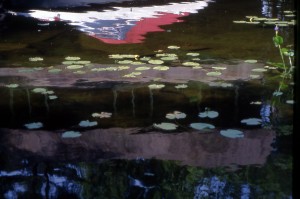Monday
Arts and Poetry, Great Lakes“I am Miksang.” An interview with Miksang teacher, Maxine Sidran

Boat by Maxine Sidran
Maxine Sidran: I first saw the word Miksang on a calendar at the Toronto Shambhala Center. My response was to the word that followed it: photography. I have practiced photography my entire adult life, and the fact that it had showed up at a meditation center was exciting.
What did you find challenging in this contemplative art form? And are there photographers that tend to influence or inspire your photography?
I didn’t find anything challenging with Miksang. It was as if I had been headed this way all along. The difference was that before, my tendency was to go out as what I call ‘a big game hunter,’ trying to bag the best trophy and bring it back to impress my friends. Miksang very quickly made me see that attitude is what GETS IN THE WAY of seeing the multitude of gorgeous images around us ALL the time.
I’ve been studying Miksang for something like ten years. I wanted to become a teacher, because I love Miksang and want to give others the chance to know about it.
There are photographers whose work I appreciate. Nobody influences my work, which is a good thing, because with Miksang outside influences are not helpful.
I remember during a class in Level III Miksang, when another student kept coming back with images I just loved. I told our teacher, John McQuade that I wanted to shoot like that student, but I couldn’t do it! I just couldn’t see what he saw. ‘But why should I?’, was the response. ‘I wasn’t him!’ So I just let go, and got comfortable with what I do see. I’m as happy as can be.

Color by Maxine Sidran
How does one discern a Miksang photo from a non-Miksang photo?
This is a very important question. “Distorting” lenses like fisheyes and wide angles, or manipulation in the dark room or Photoshop is never used. What Miksang requires is: that you BE there.
In Shambhala, which is where Miksang came from, being a “warrior” means that you give up preoccupation with your Self. Letting go of ego is a necessary precondition for real seeing. It’s what keeps prejudgment and prejudice from clouding your ability to see: “garbage is ugly, so I won’t take pictures of garbage.” Being preoccupied with the self is the greatest barrier to seeing and the hardest one to break. The philosophy is that the beauty is in the reality you see.
A new student should know how to use a camera only in terms of being able to capture what is seen.
Adjusting for light and speed is about it. There are many photos out there that qualify as Miksang photos, because they exhibit the three Miksang hallmarks of purity, space and simplicity. HOWEVER that doesn’t mean they were taken in the Miksang way, with mind and eye coordinated and no mind chatter telling the shooter what to shoot or not to shoot. This, to me, is the most important thing about Miksang. It is not simply a method to shoot pictures. It is a way of living, of meeting the world, which allows you to be aware of the beauty that is always there. Anybody can go out reminding themselves, “purity, space, simplicity,” and come back with images that look like Miksang. It doesn’t mean that they are Miksang images.

Flower by Maxine Sidran
Please describe the connection between meditation and Miksang. What is the goal of Miksang?
Miksang is not a meditation process per se, because, although it is about stilling the chatter in the mind, it is not about pulling back from the world. We quiet the mind to be able to meet the world without prejudice or preconception. When you are mindful, you are aware of the beauty in everything.
Miksang shooters clear their minds of chatter and walk into the world. They are not looking for anything. They are just being there. When they’re in that state, visual things begin to pop at them; begin to call out for their attention. In Miksang we call that “the flash of perception”, where the world, not the photographer, initiates the interaction. I like to say that with Miksang, the Universe takes a picture of itself.
The contemplative arts wake us up to appreciate life, Miksang is a contemplative art. It’s contemplative because it synchronizes the mind, the eye and world, and, by doing so, leave no room for duality. There is no I and no It. As a result, there’s no way that I can pass judgment on It.
What has changed for you (or not) now that you have studied this art form?
My interaction with the world is different. This is important. The message of Miksang is just to appreciate things as they are, and if you want to share that appreciation, do it before any thought and preconception gets in the way.
My intention is to keep shooting Miksang for the rest of my life. It’s not such a difficult intention, because by now I am Miksang and Miksang is me. I simply see in the Miksang way, even if I’m not holding a camera.
Maxine Sidran is a member of the Toronto Shambhala Center and a Miksang teacher.





